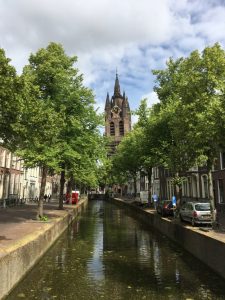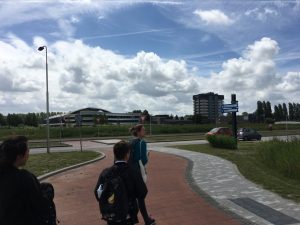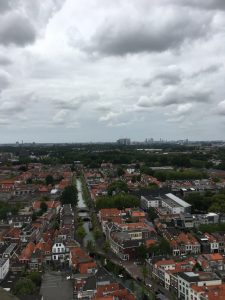Today we got to get up at a pretty reasonable hour. Our tour didn’t start until 10:00, so we had to be ready to go around 9:15. We went to the station and hopped on the train, and got off at Delft, where we were met by our tour guide. We hung out there for a few minutes while Annabel graciously fetched us water, a minor but fond memory from the morning. For all the water in the Netherlands, it was surprisingly difficult to find a water fountain in the station!
We then began our tour. Within the first couple of minutes, we saw something amazing; the first evidence of a bike in a canal! In a country with 22 million bikes and a whole heck of a lot of water, I was genuinely surprised that we didn’t see this sooner.
We also passed a bird that was, according to our guide, practicing sustainability by reusing sticks and trash to build a nest in the middle of the canal.
As we continued walking, it grew apparent that Delft is a particularly interesting town. It’s ancient yet modern; the city was founded in 1246, and some of its structures date back to the early 13th century, yet it’s also home to TU Delft, the Netherlands’ premier technical university, analogous to MIT in the US. As can be seen in a later picture, there was some kind of event held in the square, where students from the University showed off and raced small race cars that they seem to have built. It was a pretty bizarre juxtaposition to see a bunch of nerdy engineers showing off their neat feats of modern engineering while standing in front of a church dating back to the early 1500’s. A couple hundred years ago, prisoners were executed in the same square that they were now racing cars in. This mash-up of old and new was interesting, but, as we have come to learn, it’s not at all something that is foreign to the Netherlands.
In both Amsterdam, where we wound through historic streets by tapping in and out with our OV-Chipcards, and in Rotterdam, where our hyper-modern cube hostel sat just behind one of the city’s oldest harbors and a building that was the tallest in Europe for a long stretch of the 19th century, history has been integrated into the modern world, as opposed to being replaced by it.
The main square was capped on one end by the City Hall, and on the other by the Nieuwekerk (“new” church), which is actually the final resting place of the Dutch Royal Family, including William of Orange, father of the Netherlands. Some of us climbed to the top of this church, and the vista pictures below were taken from here as well.
We were also introduced to the Leaning Church of Delft (note: that’s just what I’m calling it, not its official name). According to our tour guide, this church is called “Old Church,” and was constructed in the 1200s, and the ground under one side of it was a body of water at one point, which has resulted in the land there settling and is thus responsible for the leaning of the church.
I took a lot of pictures, and I figured I’d put them in here just to help stir some memories. This building is now a museum, but it is the place where William of Orange was murdered in 1584. Next to that is a picture of his garden attached to the house, with a statue of His Orangeness in the center.
While we were walking, we passed this little gate in the canal, the purpose of which was not water management, but in fact traffic management. This was formerly on one of the busiest routes in the town, and with relatively small canals and tight corners, it was important to make sure that the waterways were usable. While this was probably not essential to have in Delft, it did make me think a bit about things that I’d overlooked earlier. We’ve talked extensively about water management, but the human component is just as important. In a port like Rotterdam, which sees the most traffic of any port in Europe (and is also pretty significantly far inland), the flow of traffic probably shaped the city just as much as the flow of water did. As our bike tour guide would go on to mention on Saturday, bridges, artificial land, and even waterfront architecture were and will continue to be determined by incoming water traffic. This is something that we didn’t necessarily discuss much in our studies, but I’d be fascinated to learn more about the ways that the need for water as a means of transportation shaped the Dutch landscape. Allocating/inserting water to the correct places is arguably just as important to the Dutch economy as removing water from their land is.
We also encountered this public square on our tour. This space apparently used to be a livestock market, but has since been transformed into a dining and social hub for Delft. The greenery in and around this space gave it a really quaint and sheltered vibe, and I really enjoyed being in this square.
Here is a piece of street art we also walked by. I was curious as to who commissioned this piece. It was clearly meant to inspire and promote women in STEM fields, and it also made me wonder a bit about the role of women historically and presently in Dutch society (as a people who pride themselves on fairness and equality). Just as a point of interest, TU Delft is roughly 27% female, and about 16% of the professors there are female. These numbers aren’t horrible, but they’re not good either. I’m interested to look into this issue further.
We got lunch after our tour, and then Annabel led the way through TU Delft’s campus and out to the Deltares offices and labs. Deltares is an independent institute for applied research in the field of water and subsurface. Their main focus is on deltas, coastal regions and river basins all over the world. Based in Delft and Utrecht, they employ over 800 people. They even have an office in Philadelphia!
There, we met Bregje van Weesenbeeck, an ecologist working for Deltares. In a room with coffee and tea (classic Dutch), she talked to us about the more technical side of water management, which we haven’t heard too much about. Dutch firms like Deltares now follow the principle of “building with nature.” She mentioned some specific methods that she and her peers employ when dealing with issues in deltas across the world, and told us about a few different projects that she had been involved with in Louisiana and Indonesia.
After that, we were taken on another tour—this time to see the Deltares testing facilities, a 300 meter long wave flume for conducting experiments and testing miniature prototypes of things like storm surge barriers. The lab functions as a water research hub for the whole of Europe, and many different organizations and institutions do research here. The facility was very impressive. One side of the roof was covered with solar panels.
After that, we went back to Delft. Some departed, and some stayed around. A few of us climbed the New Church’s narrow and cramped staircase to the top of the spire. Here are some of the views.
Inside of New Church, William of Orange (and in fact, the whole Orange lineage) is buried. There is a museum that has information about the family, and the formation of the Netherlands as an independent nation. The door to the Orange Family Crypt was at my feet when I took this photo, and the shrine in the photo sits atop of the crypt.
After touring the museum, a few of us sat down at a restaurant on the square and got some poffertjes, which is the little miniature Dutch pancake dish. It was delicious, and I think everyone cleared their plate within two minutes.
I also saw this (gross) photo of a child eating a (gross) herring, and figured I’d put it in here since I apparently messed up the (gross) video of the man eating a (gross) herring on our tour. Obviously, Professor Richter doesn’t think herring is gross.
We returned to Rotterdam, and we decided to check out the inside of the Rotterdam Public Library, which was the tiered building with all of the big yellow tubes coming out of it near our hostel. That was a good decision; the library is BEAUTIFUL. The pictures don’t do it justice, but it’s everything that a library should be and then some. There were chess boards and museum exhibits on the ground floor, and the whole building was riddled with both books and technology, with common spaces and more isolated spaces, and with plenty of natural light. The escalators cascaded down the front of the building like a waterfall, and just being in the library was inspiring—a sentiment that was shared by all four of us that ventured in.
I think this building is a prime example of what an educational building should be, and it’s also a testament to the Dutch mentality. It was not strictly a place to hold books; it was a place to learn, to live, and to relax. It was a social hub as much as it was an educational hub. There were teenagers and adults playing chess on the ground floor, there was a theater and a movie theater and a café on the rear end of the building, and there was even an area just full of video game consoles. In making the library a diverse and engaging place, the Rotterdam City Government has effectively found a way to draw all kinds of people into this place of learning. By making the library a fun place to be, rather than a boring place strictly dedicated to holding paper knowledge, and creating social spaces within the building, I think that a library to a Dutch person living in Rotterdam has a completely different connotation than it does to any given US citizen. I’m not exactly sure what this means long term, since I only got to spend about 20 minutes in this place (it was starting to close for the day as we walked in), but I can only imagine that it helps to foster a general attitude towards learning and towards books that is much more positive than it is here in the US. The implications for this are clearly immense; a more educated and informed populace goes so far for the overall well-being of a country, in ways that I won’t even begin to talk about here.
It’s quite possible that I’m over-extrapolating here—maybe it is just a cool building and not as significant as I think it is. But whether or not this specific building has a large social impact in and of itself, I think it’s symbolic of something greater. The Dutch are excellent engineers, both of the natural world and of human systems. They clearly put a lot of thought into almost everything that they build, and I definitely think that it pays off. Though certainly far from perfect, I think the Netherlands has a lot going for it, and I really enjoyed our time there. Despite what our current government thinks, the US has a lot to learn from the rest of the world, and the Netherlands has a lot to share.
Damien

























